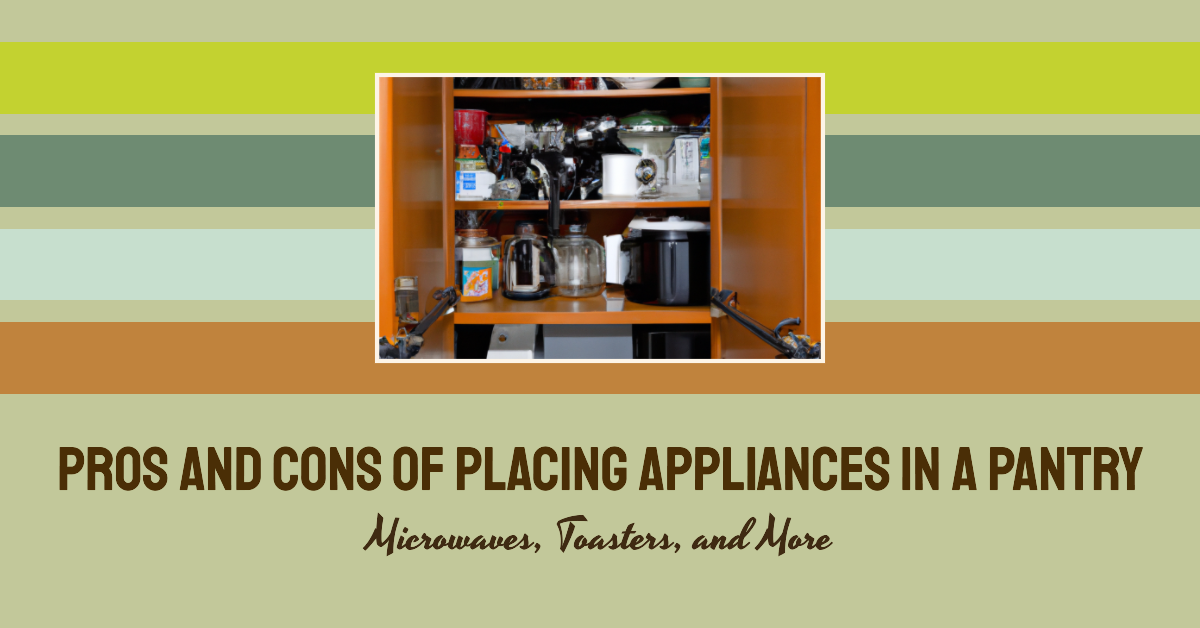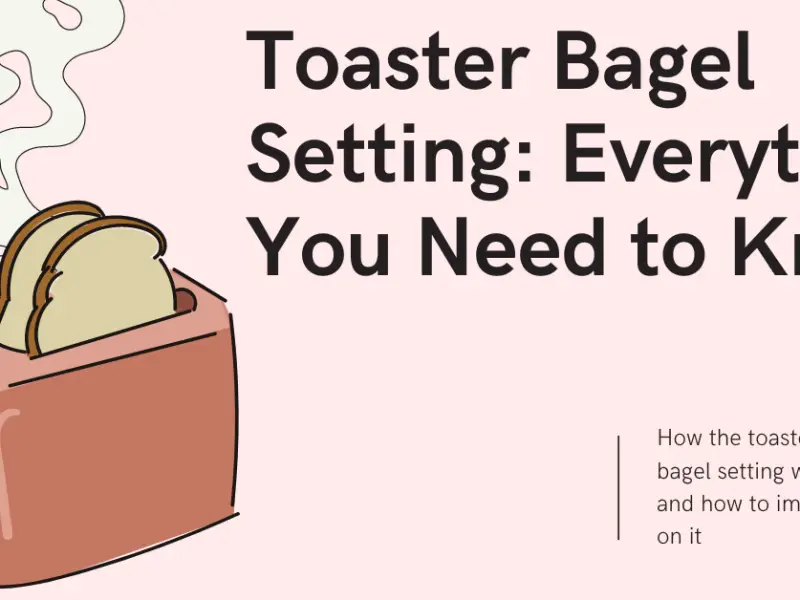I am a well-rounded expert with proficiency in several fields. My experience spans from being a dedicated chef and homemaker. As a passionate homesteader, I’ve honed my skills in sustainable living and animal care, ensuring a holistic approach to everything I undertake. Email me or Txt: (# removed due to spam, please email)
A well-organized kitchen can significantly impact the overall efficiency and enjoyment of your cooking and meal preparation experience. One option for decluttering your kitchen is to place some of your appliances, like microwaves and toasters, in the pantry. This article will explore the advantages and disadvantages of this storage solution and provide tips for successfully incorporating appliances into your pantry.

Advantages of Storing Appliances in a Pantry
Space-saving benefits
One of the most significant advantages of storing appliances in a pantry is the space-saving benefits it provides.
Appliances like blenders, mixers, and slow cookers can take up valuable counter space in a kitchen, making it challenging to prepare meals or work comfortably.
By storing these appliances in a pantry, you free up counter space, making your kitchen appear more spacious and less cluttered.
This extra room can give you the freedom to prepare meals without feeling cramped and can make cleaning easier.
Aesthetics and cleanliness
Storing appliances in a pantry can contribute to a cleaner, more streamlined look in your kitchen. By keeping them out of sight when not in use, you maintain a more organized appearance.
Additionally, appliances stored in the pantry tend to accumulate less dust and dirt, which can help maintain their cleanliness and functionality.
Clean appliances not only look better but also perform better, ensuring that they last longer and function properly.
Accessibility and organization
Having a dedicated space for appliances in your pantry can improve overall organization.
By knowing exactly where your appliances are, you can quickly access them when needed, saving time and effort in the kitchen.
This can be particularly useful for busy families or those who frequently entertain guests.
By having everything in one place, you can easily find what you need, which can make meal prep and clean-up much more efficient.
Protection and preservation
Storing appliances in a pantry can also help protect them from damage caused by exposure to sunlight, moisture, or temperature changes.
For example, storing your coffee maker in the pantry can help prevent it from being exposed to heat and moisture, which can cause the machine to malfunction over time.
Additionally, keeping your appliances out of direct sunlight can prevent the plastic or metal components from fading or cracking.
By storing appliances in a pantry, you can help preserve their lifespan and keep them functioning properly for longer.
Versatility and flexibility
Storing appliances in a pantry can also provide greater versatility and flexibility in your kitchen.
If you have limited counter space, you may need to choose between keeping your blender or your toaster on the counter.
However, by storing these appliances in a pantry, you can switch them out as needed, depending on your meal prep needs.
This can be particularly useful for those who enjoy cooking or baking and may need access to multiple appliances at once.

Disadvantages of Storing Appliances in a Pantry
Inconvenience and reduced functionality
While storing appliances in a pantry can help free up valuable counter space, it can also make them less accessible than if they were placed on the counter.
You may need to walk a few extra steps or move other items to reach your appliances, which could be inconvenient, especially when multitasking during meal preparation.
Additionally, some appliances probably shouldn’t be used inside a pantry, like blenders or food processors, as they may require a stable surface to work correctly, which may not be available in a pantry.
Limited ventilation and potential safety concerns
Proper ventilation is essential for certain appliances like microwaves and toasters.
Storing these appliances in a pantry without adequate ventilation can lead to overheating or even fire hazards.
Additionally, insufficient ventilation can cause damage to the appliances over time.
It’s crucial to ensure that the pantry has proper ventilation or that the appliances are moved to a different location in the kitchen with better ventilation.
Additional considerations: Pantry size and layout
The size and layout of your pantry may limit your options for storing appliances.
You may need to rearrange or modify your pantry to accommodate the appliances, which could require time, effort, and financial investment.
Some pantries may not have enough space to store larger appliances, like a standing mixer or a large slow cooker.
It’s essential to assess your pantry’s size and layout before deciding to store appliances in it.
Weight and storage capacity
Some appliances can be quite heavy and may require sturdy shelves to support their weight.
Storing heavy appliances in a pantry that doesn’t have adequate shelving could lead to damage or even injury.
Additionally, some pantries may not have enough storage capacity to accommodate all the appliances you want to store, which could limit your options and require you to choose which appliances to store and which to leave out.
Humidity and temperature control
Some appliances, like bread makers or dehydrators, require specific temperature and humidity levels to function correctly.
Storing these appliances in a pantry that doesn’t have proper humidity or temperature control could lead to damage or malfunction over time.
It’s important to ensure that the pantry environment is suitable for the appliances you plan to store.

Tips for Successfully Storing Appliances in a Pantry
Choose the right appliances for pantry storage
When selecting appliances for pantry storage, consider the size and ventilation requirements of the appliances.
Smaller appliances like blenders, coffee makers, and toasters are generally more suitable for pantry storage than larger appliances like standing mixers or slow cookers.
Additionally, consider the power requirements of the appliances and ensure that your pantry has adequate electrical outlets (If you intend on using the appliance inside the pantry).
Organize your pantry for optimal efficiency
To make the most of your pantry storage, create an organized layout that maximizes available space.
Use shelves and racks to store appliances and other pantry items, and arrange them in a way that makes them easily accessible.
Consider labeling shelves or using clear containers to help you quickly find what you need.
You may also want to keep frequently used appliances, like your coffee maker or toaster, closer to the front of the pantry for easy access.
Or better, Keep those often used appliances on the counter since you have all this extra space now.
Ensure proper ventilation and safety precautions
Proper ventilation is critical for appliances stored in a pantry.
To ensure safe and efficient operation, keep appliances away from flammable materials, and consider installing a ventilation system or using appliances specifically designed for enclosed spaces.
For example, some microwaves have built-in fans that help circulate air and prevent overheating.
It’s also essential to follow manufacturer instructions and safety guidelines when using any appliance, regardless of where it’s stored.
Consider using storage solutions
To maximize available space in your pantry, consider using storage solutions like adjustable shelves, hanging racks, or pull-out drawers.
These can help you make the most of available space and keep appliances organized and easily accessible.
Additionally, consider using containers or baskets to store smaller items like attachments or utensils, which can help keep your pantry tidy and clutter-free.
Regularly clean and maintain your appliances
Regular cleaning and maintenance can help ensure that your appliances remain in good working order and last longer.
Follow manufacturer instructions for cleaning and maintaining your appliances, and be sure to wipe down any surfaces or components that come into contact with food.
Additionally, inspect your appliances regularly for signs of wear or damage and repair or replace them as needed.

Conclusion
Placing appliances in a pantry has both pros and cons. While it can save space and contribute to a cleaner, more organized kitchen, there are potential drawbacks like inconvenience and safety concerns. When deciding whether to store appliances in your pantry, carefully weigh the benefits and drawbacks based on your specific needs and kitchen setup. If you choose to proceed, follow the tips outlined in this article to make the most of your pantry storage solution.



